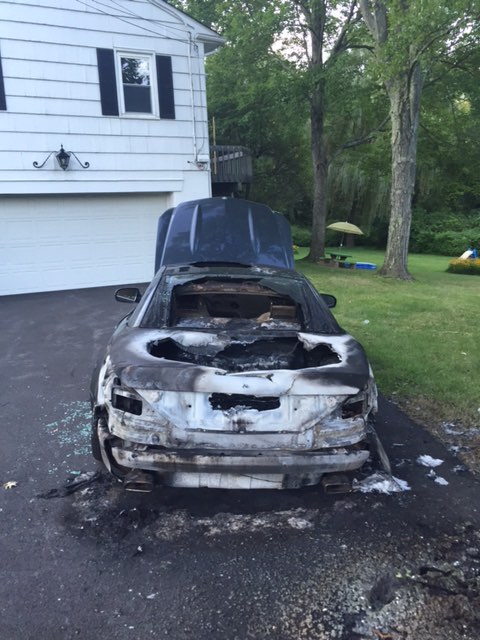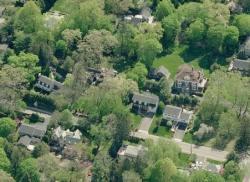Trash Talk: Scarsdale Sanitation
- Details
- Written by Jill Fisher
- Hits: 6760
 After finding a pile of crushed glass and plastic bits in front of my house last week (very colorful, but not what you want on your street) -- I took a photo and went down to the Sanitation office on Secor Road to lodge my complaint.
After finding a pile of crushed glass and plastic bits in front of my house last week (very colorful, but not what you want on your street) -- I took a photo and went down to the Sanitation office on Secor Road to lodge my complaint.
Nancy at reception was not happy. She called the supervisor, Steve, who came right out to say that he was glad I had reported it, and that he would send someone out immediately to clean it up.
In 20 years living in this community, I have been annoyed to see bits of trash on the streets, paper flying out of the Cushmans (those little carts sanitation uses have a name), and occasionally messy spills near the train station. I never really thought about the job done by the Sanitation Department, so I decided to talk to Benedict Salanitro, who has been the Superintendent of Public Works for the past 18 years.
It turns out garbage collection is more complicated than I realized.
Why does stuff full out of the truck, I wanted to know. He explained that the older trucks have turn- buckles that require a perfect seal. If not tightened enough (yes, human error and/or aging equipment) the result can be liquid or trash (like my little pieces of glass) dropping off the truck. The foreman is responsible for noticing this, and is instructed to send a cleanup crew if he cannot resolve the problem on his own. The Department is working on having hydrolic closers, which would be more effective.
In addition, the Sanitation Department is looking at replacing the Cushmans that we see zipping around town. Parts for these vehicles are no longer available, and the idea under consideration is to use pick-up trucks ("satellite vehicles") that report to the "mother ship" (the big vehicle that we all call a "garbage truck"). The Cushman have been very useful because Scarsdale has always had "white glove" collection, which means that trash is still collected in the rear of the home, with the exception of yard waste, bulk trash and paper recycling. In most towns residents are required to bring all their trash to the street for pick-up. Interestingly, White Plains requires curbside collection, and is using trucks with a robotic arm. (21st century trash collection!). The post-Cushman era in Scarsdale will require more walking, and the expectation is that crews will be working more as teams instead of individually as they work now.
I also found out that Scarsdale Sanitation does not service the commercial establishments, as the restaurants around the train station. Private carters are hired, so any messes (like the five gallons of coffee spilled onto the street that was recently given a violation notice) is as much of a problem for the Sanitation Department as it is for residents.
What struck me was the high level of accountability that Mr. Salanitro expects from his staff. All complaints are logged, and new hires are told that their two priorities are to keep the village clean and to be safe. Hauling trash takes a toll on the body, and probably half of the staff has worked in the village for less than five years.
The conclusion I draw from all of this is that our village is pretty clean, our Sanitation Department works pretty hard and we should not expect the sanitation workers to be responsible for every piece of trash on the road. I would even propose a radical idea: it wouldn't kill us to pick up a bit of litter ourselves, especially if it's around our own property.
Residents Make a Case for a New School
- Details
- Written by Joanne Wallenstein
- Hits: 4665
In June, 2016 architects presented a compromised plan to build a new school and save the lion's share of the field in Greenacres.
Three fathers of young children addressed the board, presenting why they believed the revised plan for the new school at the rear of the field answered opponents concerns and would better serve children now and for the next 100 years. John Krisberg, Gabriel Streche and David Schwartz offered the perspective of young parents who said a new school was "not just for this generation but for generations to come." They applauded the district for coming up with a compromise plan for a new school that would save the lion's share of the field and the blacktop and meet the needs of the students.
In a measured and unemotional presentation they contended that the plan for a new school, built on the present field, parallel to Brewster Road would do the following:
First and foremost, the new school would meet model program requirements and provide ample classroom space for children of all grades. The model program calls for 950 square feet for kindergarten classroom and 850 for grades one through five.
All classrooms in the new school would meet this mandate. If the district chose to renovate the existing school, plans call for the K-2 classrooms to remain as is, and all are smaller. In fact, this past year, in one classroom, kids sat on the floor rather than at desks, so that there would be enough space in the room for class activities. For the current school year, an additional child moved in to Scarsdale after the deadline, and there is a second grade class with 23 students in a 611 square foot classroom.
The new school would have a spacious cafeteria, a kitchen, music rooms, a maker space and an additional multipurpose room as well as an additional classroom. Though space in the existing school has been repurposed to meet student needs, the cafeteria is inadequate, and three lunch periods are required.
Architects have proposed geothermal heating and cooling for the new school, which they estimate would pay for itself in energy cost savings over 10-15 years. In the renovation plan (B1), $8.5 million would be spent to install a non-energy recovery HVAC system in the basement of the school, an area that is damp and has been a cause for concern. The original renovation plans called for an energy recovery HVAC system on the roof, but that was shelved to save money. In addition, the first phase of the renovation plan does not include some future infrastructure needs for the existing building such as a new room and windows that will have to be replaced down the road.
On the exterior, proponents for the new school argue that the C1 plan will:
• Save the preponderance of the existing green space
• Provide play areas adjacent to the school, eliminating the need for children to cross the street to play
• Provide bathrooms adjacent to the playground
• Offer additional parking spaces
Last, these parents felt there was less risk to children to build a new school than renovate the existing building with the children inside. Architects estimate it would take 1.5 to 2 years to build a new school. During that time, the children would stay in the old school with limited use of trailers when necessary. Some parents have raised concerns about lead paint, dust, asbestos, construction noise and safety and believe it would be best to keep the children out of the school during a renovation which is estimated to take three years.
In terms of cost, proponents for the new school believe that in the long run it will be more efficient to spend $53 million now, rather than $41 million to repair and maintain a one hundred year-old building. Furthermore the district would finance a new building over 30 years, while limiting financing for a renovation to 15 years to coincide with the useful life of the renovated facility.
They have launched a website that you can view here:
Though they made a persuasive case for their view, strong opposition to knocking down the existing Greenacres school remains. The Scarsdale School Board has heard strong arguments from those who wish to maintain neighborhood character, preserve Scarsdale's first school, maintain the field and the blacktop and keep the large baseball diamond. Those who live around or near the field argue that their needs as residents should be considered. Furthermore, they contend that parents' fears about safety during construction are unfounded, citing other projects that have been undertaken while the children remained in school.
A recent email circulated by the Committee to Save Greenacres, urged residents to send emails to the Board of Education prior to their first meeting of the year on September 12. They argue that:
• It will cost "tens of millions" less to renovate rather than construct a new building.
• Preservation and renovation is best and will allow the Board to fund other district needs.
• A safe renovation can be achieved and the model program requirements can be met.
• The renovation will be undertaken with vigilance according to strict state code and the highest standards of safety and environmental abatement.
• Residents will have the ability to use the field during the renovation.
• The full Greenacres field and the baseball diamond will be preserved along with the character of the neighborhood.
Last, they urge supporters to tell the Board that they will not vote in favor of a bond that funds a new school.
Learn more about their campaign here:
Due to opposing views from residents and financial constraints, the administration later recommended that the issue be tabled. In a memorandum in the agenda for the September 12th meeting, Superintendent Hagerman and Assistant Superintendent Stuary Mattey discuss the need for a district-wide master plan, high bids for already approved capital projects and a polarized community as reasons to hold off on making a decision about Greenacres.
However, delaying a decision could possibly cause more discord, as Greenacres residents were long ago promised that the aging school would be upgraded or replaced. With no solution on the horizon, real estate prices in Greenacres may be affected by continuing uncertainty about the fate of the school. If and when the next bond comes to a vote without a solution for the school, it could meet opposition from Greenacres' residents who believe their school is substandard and they are not getting their fair share from the district.
The issue is anything but settled. Watch or attend upcoming school board meetings and read Scarsdale10583.com to stay informed.
Power Line Burns Cars
- Details
- Written by Joanne Wallenstein
- Hits: 5524
 A high tension power line was damaged by a falling tree branch on Rural Drive on Monday afternoon and caused a Mercedes Benz to burn up and damaged a Porsche that was in the driveway. According to Captain Allan Gleason, who was the tour commander for the fire, the department received an initial report of a downed power line and brush fire. However, when they arrived on the scene, the high voltage power line was arcing, and threatening both the cars and nearby homes.
A high tension power line was damaged by a falling tree branch on Rural Drive on Monday afternoon and caused a Mercedes Benz to burn up and damaged a Porsche that was in the driveway. According to Captain Allan Gleason, who was the tour commander for the fire, the department received an initial report of a downed power line and brush fire. However, when they arrived on the scene, the high voltage power line was arcing, and threatening both the cars and nearby homes.
Firemen could not combat the fire until Con Edison arrived to disconnect the line. When they did, it was too late to save the Mercedes convertible, which was burned and totaled. The Porsche did sustain damage but was drivable after the incident.
When Con Edison disconnected the line, they also caused outages at nearby homes and the Scarsdale Pool Complex which is on the same power grid. The fire department sent out three fire trucks, a ladder truck and two officers to fight the fire, and they were successful at containing it to the driveway of the home.
Annual Book Sale Begins September 10th
- Details
- Written by Joanne Wallenstein
- Hits: 4362
 Westchester County's premier book sale at Scarsdale Library will begin on Friday, September 9th from 6 to 9 pm at a "Friends" Preview. New members may join at the door that evening for $25. The sale will run until Sunday, September 18th.
Westchester County's premier book sale at Scarsdale Library will begin on Friday, September 9th from 6 to 9 pm at a "Friends" Preview. New members may join at the door that evening for $25. The sale will run until Sunday, September 18th.
New books are added to the sale daily.
The Book Sale offers more than 60,000 current and out-of-print books, including bestsellers, classics, biographies, fiction, parenting, cooking, art, graphic novels, humor, travel, self-help, drama, religion, philosophy, poetry, history, political science, and business. There is also a huge selection of children's books, plus DVDs, CDs, LPs, audiobooks and sheet music. Be sure not to miss the large category of highly collectible books, rare books, limited and first additions as well as the trove of autographed copies available. Proceeds from the sale help the library provide exciting programs and key services.
About The Friends of Scarsdale Library
The Friends of the Scarsdale Library was formed in 1968, with the primary goal of supporting the Library as it serves our community. We strive to focus public attention on the Library's services, facilities, and needs. Check out their membership page to see how you can be a part of all we do for our library.
Friends of Scarsdale Public Library Book Sale Schedule
Friends Preview
Friday Sept. 9 6 pm – 9:00 pm
Regular Sale
Saturday Sept. 10 9 am – 4:30 pm
Sunday Sept. 11 9 am – 4:00 pm
Monday Sept. 12 11 am – 8:00 pm
Tuesday Sept. 13 11 am – 8:00 pm
Half-Price Sale
Wednesday Sept. 14 10 am – 8:00 pm
Thursday Sept. 15 11 am – 5:30 pm
Friday Sept. 16 11 am – 5:30 pm
Blow-Out Sale
Saturday Sept. 17 9 am – 4:30 pm
Sunday Sept. 18 9 am – 4:30 pm
Scarsdale Public Library
54 Olmsted Road --corner of Post Road, Route 22
Scarsdale, NY
914-722-1300
www.scarsdalelibrary.org/friends
Wanted: Used Books and Chess Players
- Details
- Written by Joanne Wallenstein
- Hits: 4108
 Last Call for Books for the Friends of the Library Book Sale:
Last Call for Books for the Friends of the Library Book Sale:
There's still time to donate gently used books for The Friends of the Scarsdale Library Book Sale in September. Donations will be accepted through August 26. Please leave your donations outside the Scott Room.
Please bring only books in saleable condition. Damaged, moldy or dog-chewed books, cannot be accepted. Also please do not bring textbooks, encyclopedias, magazine or VCR tapes.
For information about volunteering, contact Kathy Steves, Book Sale Manager at steves10583@gmail.com.
Chess Players Wanted:
Do you play chess? Want to learn or refresh your memory? DOROT is starting an Intergenerational Chess Program for adults 65+ and middle and high school students. It is a great opportunity and if you are 65+ and interested in participating or know someone who would be interested please have them contact DOROT's Westchester Director, Cippi Harte at 914-573-8906 or via email pcharte@dorotusa.org..














